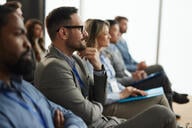You have /5 articles left.
Sign up for a free account or log in.
I am going to give you some practical, productive advice on how to easily frame that first email contact in the world of cold-calling and networking. My take comes from years of writing this type of correspondence and through coaching others on how to get better responses on this important first connection. That said, email communication between individuals is an art, not a science. There is a dynamic in play involving your writing style and the receiver’s reaction to it. So read on and use your own judgment because you know what it is like to receive an email and that can guide your writing process too. Let’s start at the top with the first key element -- the salutation.
The Salutation: Please do yourself a solid and always err on the side of formality in your introduction for an initial email. Starting with “Dear Dr. Who” or “Dear Ms. Oswald” will carry you far. There is little risk in being more formal and a boatload of risk in starting out informally using the receiver’s first name and/or the ubiquitous “Hi” or “Hey” when you have never met them and you are establishing a professional connection -- so why risk it at the get-go? Just use “Dear.” After this initial email, take your cue from the receiver. If they respond to your email with their first name and start their emails with “Hi” you may consider becoming more informal in your introduction. I would also recommend avoiding the “Greetings” salutation, which can sound a lot like artificial intelligence. Additionally, a little online reconnaissance will help you determine the preferred title of your intended target. This is easy to do and worth the time (thank you social media). Frankly, I could write a whole article on the lost art of appropriate greetings, but then I would further date myself and really underestimate you, Dear Reader. So, I will move on to the other key elements of the introductory email.
Context for connecting and why you are writing: The receiver needs to immediately see a compelling reason for reading beyond the first sentence. You know this already, because this matters to you when you skim your inbox on your iPhone. First, I recommend that the flat, sad start of “My name is” be banished from your writing. It tells the receiver nothing but what they will already see when you sign off and it is not a compelling reason to read on. Instead, cut to the chase and let your contact know, in a concise and welcoming way, why you are making the connection.
For example, are you writing on the recommendation of another person? Have you read their article and would like to connect on something regarding what they wrote? Did you read their profile on LinkedIn and find connection in their professional background to your research interests? You can add body and detail to this after you provide context in this first line or two. Remember that a bit of enthusiastic observation can go far in creating a human connection. So, adding observations in the body of the email about their “interesting work in…” or “accomplished background in…” with some specific text on why this is meaningful to you can be the next level of engagement. Get specific on what it is you find compelling about the receiver’s background and how it connects to you. My only word of caution here is that in some academic settings, too much enthusiasm can seem “intellectually suspect,” so perhaps a bit more of an understated positive observation might work better. (Ask a trusted adviser to vet an email and/or use your judgment to help guide you). In the end, remember that an email that is concise and broken up into smaller chunks is more likely to be read (again, you know this). So avoid a mini biography or long explanations. You can always attach a C.V. or resume for background, if appropriate.
The Directed Ask: Once you have a formal greeting and a clear reason as to the context for connecting, it is time to tell the recipient specifically why you are writing – that is to say, what is it you are asking from him or her. You know and they know you are not writing just to share your thoughts and background. You are trying to initiate a professional connection by reaching out. The good news is that you know how to do this in other settings instinctively so you can put those good instincts to work here. Think about it this way: Let’s say you are at a party and you meet someone new and you see you have a few things in common after the initial small talk.
After the greeting and initial connection, you don’t then say, “Do you think we should be friends?” No. That would be the “Big Ask” and, frankly, kind of weird. You have crossed that boundary too fast. You really need to have some smaller asks before that bigger one. You know and understand this and can apply it to the context of an initial “cold-call” email. You may ultimately want to work for or with the person you are writing or you may be curious about what might be some of the bigger things they can do for you. But all you want to do in this initial conversation is to make a calculated first-step ask. And it is most helpful if this ask is specific. So be clear and decisive about the potential next steps.
Do not leave it to the receiver to decipher what you want or do a lot of work in setting up what you want. Make it as easy as possible for the receiver to respond. It can be as simple as, “I will be in your area on December 15 and would really enjoy meeting with you for a half hour to gain your perspective on… .” Suggest times, perhaps, or a method or venue for the meet-up. I would also suggest you do this in a statement versus a question. So instead of “Could we meet to talk?” I would suggest. “Let me know if you would be available to meet on the afternoon of December 15.” It reads more decisive and less tentative, and it gives them a specific action to which they can respond quickly.
With each contact be selective and appropriate with your ask (remember the creepy “be my friend” analogy). After meeting or further emails that lead to a more established connection, your "asks" may get bigger. You are building a relationship. Be deliberate and create buy-in as you go.
The Subject Line: Finally, remember that the subject line is key in getting the email opened. So choose a short and specific topic that has personal significance to the reader such as “Connecting at the Upcoming MLA Conference” or “Referral from Prof. Smith” or “Responding to your January 13 article on… .” Again, you know what subject lines get you to open an email, so apply that knowledge to this task.
I hope you find this article useful when you write your next email, but use this advice to inform your process, not to dictate it. Take this writer’s recommendation with a dose of judgment – yours. Good luck!




